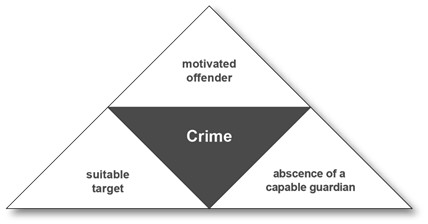16. Environmental Criminology
16.4 Theoretical Approaches Within Environmental Criminology
Antonio Robert Verbora
The following section discusses the key environmental criminology theories that seek to explain the causes of crime. It is important to note that each of the following theories discussed has its own strengths, weaknesses, as well as gaps, and is applicable (in this case) to the understanding of environmental criminology in general. It is worth noting that some of these theoretical approaches can be applied to study other crimes under the umbrella of criminology and can be used for other disciplines as well (psychology, economics, etc.). For the purposes of this chapter, the four theoretical frameworks to be discussed are routine activity theory, geometric theory, rational choice theory, and pattern theory.
Routine Activity Theory
One of the main theories associated with environmental criminology is routine activity theory. Routine activity theory predicts how changes in social and economic conditions influence crime and victimisation and it has become one of the most cited theories in criminology. It was first posited in 1979 by Lawrence Cohen and Marcus Felson, who defined routine activity as “any recurrent and prevalent activities which provide for basic population and individual needs, whatever their biological or cultural origins” (Cohen & Felson, 1979, p. 593). Essentially, the activities we all engage in through the days, months, weeks, and even years of our existence are all associated with our routine activities: these activities can range from extra-curricular, to work-related, to school-related activities—for example, going to work, attending school, seeing one’s friends, or running errands. Further, these activities are commonplace and involve multiple people moving through space and time (Andresen, 2010; Felson, 2013; Felson, 2017). If we want to look at changes and crime trends, we can refer to Cohen and Felson’s (1979) notion that these changes are closely associated with changes in routine activities, which are closely associated across time, across space, or between individuals.
Routine activity is not a general theory of crime; however, it has been expanded to explain a plethora of crimes (Felson, 2013; Felson, 2017). It is important to note that this theory focuses on the actions of individuals, rather than the neighbourhood and its characteristics. Moreover, routine activity theory is closely associated with human ecology (Andresen, 2010, p. 14), which is significant because it takes into consideration the importance of time. In the context of time, human ecologists state that “ecology is generally defined as understanding how a population (humans, for example) survives in an ever-changing environment” (Andresen, 2010, p. 15). So, where we work, where we live, and where we mingle (all associated with space) are where we spend our time; however, also knowing when we are at those specific places and locations is important. As such, routine activity theory acknowledges the important interplay between space and time in everyday activities, including criminal activity.
Routine activity theory focuses on crimes that involve (1) at minimum, one motivated offender, (2) one suitable personal or property target, and (3) the absence of a guardian capable of preventing such a violation (Cohen & Felson 1979; Felson, 2013). For a more detailed explanation of these three elements refer to Table 16.1 below. These three essential elements help explain why crime is likely to occur as they converge in space and time (Felson, 2017). As Andresen (2010) states, “it is the convergence in time and space of these three elements that is necessary for a crime to occur; moreover, it is the changes in the nature of this convergence that changes crime” (p. 17). For a visual illustration, see Figure 16.1.
| Motivated Offender |
|
|---|---|
| Suitable Target |
|
| Absence of a Suitable Guardian |
|

To conclude, routine activity theory has traditionally been used to explain residential break and enter, burglary, domestic violence, and physical assault. This theory provides significant insight into the causes of crime problems as it pertains to a particular place (e.g., drug dealing locations) and amongst victims (e.g., domestic violence). The theory explains why crime is often concentrated at specific places and locations and contributes to the understanding of the uneven spatial and temporal distribution of such crimes. More specifically, spatial and temporal patterns in family, work, and leisure activities influence what kinds of situations emerge, and changes in a society’s routine activities can cause changes in the kind of situations people confront.
requires that a potential offender, a suitable target, and the absence of a capable guardian must come together in order for criminal activity to be realized
refers to the study of the dynamic interrelationships between human populations and the physical, biotic, cultural and social characteristics of their environment and the biosphere

